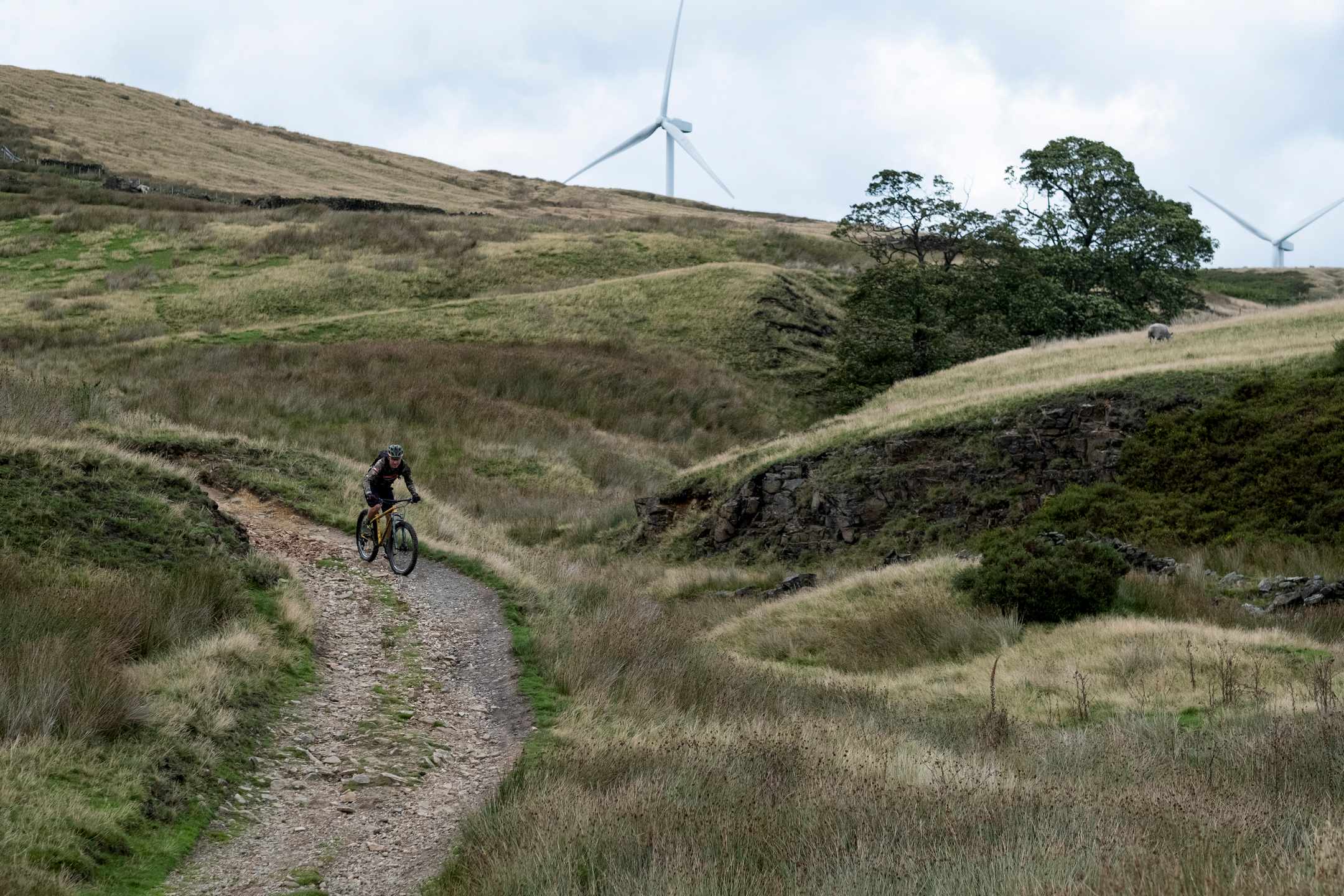First published in Issue 127 of Singletrack Magazine, this Shand Shug was reviewed as part of our British Steel test of steel hardtails built in the UK.
Shand Shug
- Price: £995.00 (frame only)
- From: Shand, shandcycles.com
Shand has been building custom steel frames in Scotland since 2003, but in the last few years it has stepped up a gear, adding a bunch of off-the-peg models to the range, and becoming a relatively big name in the long-distance adventure cycling world, thanks to its sponsorship of riders like members of the Adventure Syndicate. When Jenny Graham broke the unsupported round-the-world cycling record last year, it was on a Shand, and the brand is still best known for road and gravel bikes which look smart, but not too Gucci for a winter club run or a bikepacking adventure.

The Shug is, therefore, quite a radical departure for Shand, and its genesis was an interesting one. It began life under the banner of another brand, Trillion, that made its debut back in 2017 with a long travel UK-made 29er hardtail. The geometry and the British connection were enough to attract a fair bit of interest, but the prototype frames were distinctly rough around the edges. So Trillion partnered up with Shand for production, jointly developed and launched the Shug, and then stepped away, leaving Shand with a bike that neatly filled a gap in its range.
The Shug is clearly designed to be ridden in places where you’d normally look to four to six inches of rear suspension for comfort and control. First of all, it boasts some fairly extreme geometry, with a 64° head angle, a 75° seat angle, a roomy but not rangy 445mm reach, and a stubby 100mm head tube to keep the front end low.
Then there are those tyres: up to 2.6 inch if you run it as a 29er, or 3.0 inch in 27.5+ guise. Big tyres are nothing new in the mountain bike world, but it’s rare to see them coupled with properly slack head angles and long front triangles. Some bike companies even go the other way, and rein in the geometry on their big-shoed models, for fear of startling their more conservative customers. There are no such concerns in evidence with the Shug, and the bike’s overall demeanour is neatly summed up by the small decal on the seat tube, depicting a Sasquatch-like forest beast that might rip the limbs off an unwary traveller, or at least trample you under its size 14 feet.

But under the shiny yellow paint job (or any of the other 30 colours that Shand offers – not counting the custom finishes) it has a refined heart. There’s a Reynolds 853 front triangle and Dedacciai stays. The rear triangle meets at classic cowled dropouts (CNC machined in the UK, naturally) and the frame has simple but neat detailing, with external cable routing (using the same beefy CNC machined guides as 18 Bikes) and a single set of bottle cage mounts on the down tube.
The Shug is available in a full range of sizes from small to XXL, and if you’re looking to splash out on a forever bike, custom geometry is also possible, for a £200 surcharge. All the sizes sport the same 435mm chainstay length, which gives a generous rear triangle that looks like it could accommodate a 36er wheel, let alone a 29er. The frame-building gymnastics needed to squeeze in these volumes of tyre are achieved very simply and cleanly, using just a couple of steel plates to put the chainstays in the right place while giving the drivetrain enough clearance.
Like the other two frames in this test, the Shug takes 130mm forks, and Shand is offering the frame as a bundle with Cane Creek’s excellent Helm in coil or air variations. There are no complete bike builds available, but the parts our test bike was built up with are an interesting insight into Shand’s vision of how the Shug should look.

Apart from the fork, and a Shimano XT drivetrain and brakes, the bike arrived shod with some imposing 2.8in 27.5+ tyres mounted on Hope’s excellent Tech 35W wheelset. Schwalbe’s Magic Mary has long been a favourite front tyre for riders who’ll happily trade a bit of uphill speed for grip and control, and on a wide rim, in its 2.8in version, it’s something to behold. With the same size Nobby Nic in the rear, the Shug looks like the sort of bike that Mint Sauce would ride in a cartoon. Shimano’s in-house component brand Pro supplied the dropper post, and a short Pro stem and an appropriately proportioned 800mm set of Renthal bars made the beast complete.
The Ride
My first ride on the Shug was an abortive affair, when I tried to raise the dropper post slightly and found it was stuck fast in the frame. The issue was solved by squibbing a load of GT85 into the seat clamp slot, then applying as much brute force as I could muster. I’m mentioning this not to mark this particular bike down, but as a reminder that seized dropper posts are an unfortunate hazard of steel frames. In fact, if you’re reading this after a wet summer, and you have one languishing in your shed, garage or cellar, put this magazine down now, find some grease, and go give it some TLC. There, that’s better.

Having sorted the seatpost, I got on with pitting the Shand against some classic local trails. As you’d expect, with its huge tyre volume and capable suspension, it really does take a lot to faze it. The Cane Creek fork initially lacked a bit of support, but after I tweaked the set-up and worked out how to equalise the positive and negative air chambers, it started to give a confidence-inspiring performance that belied its relatively modest 130mm travel. While there’s still a school of thought that says hardcore hardtails need to have extra travel at the front to compensate for the lack at the rear, this definitely doesn’t feel the case with the Shug. The mountain bike equivalent of a comb-over it is not.
While it’s possible to run the Shug as a normal 29er, the bigger 27.5 x 2.8in tyres bestowed frankly silly amounts of grip, and thanks to the geometry, your body weight should be in the right place to make use of it. Schwalbe also seems to have nailed the balance between overall tyre weight and sidewall toughness, and there were none of the usual issues that I’ve experienced where Plus tyres meet rocky trails beneath a slightly clumsy rider.

Of course, you’d expect a bike like the Shug to be good at gnarly descents. What’s really surprising is how capable it was as an all-rounder, even in Plus mode. Long rides out to far-flung trails were a much less depressing prospect than you’d expect. The Hope wheelset isn’t particularly light, and the tyres weigh slightly north of a kilo each, so I’m not sure quite why the Shug was so eager to cover ground. However, it did bear out my initial impressions of the bike from a quick go at last year’s Scottish Mountain Bike Conference where it dispatched a 30-mile loop around the Cairngorms with ease. The 30.9mm seat tube and long chainstays also help give a cushy ride, although when you’re riding along on 14 psi then things like tube profiles become almost academic.

That’s not to say the Shug is all fun, all of the time. It felt a bit dead on flat pedally trails. This wasn’t because it handled badly, but because it made anything too gentle seem ridiculously easy. If you go large with full-on 29 x 2.6in tyres, you’ll lose potentially valuable mud clearance, thanks to the straight seat tube. With 27.5 tyres fitted, the Shug’s BB is also on the low side, which may not be ideal if your trails, like ours, are frequently scoured by rain into rutted rock-strewn messes. The latter of these issues could easily be addressed by plumping for 29er wheels and tyres; the former, by finding some more challenging trails. And with the Shug being so easy to tap out the miles on, you’ve got no excuse for not riding further.
Overall
The Shug may look like a cartoon of a mountain bike, but it’s no joke on the trail. If I was guiding in big mountains for a living and wanted an ultra-reliable bike that I could ride all day without being worn down or beaten up, it would be somewhere on the list.

I’ve ridden bikes that are more playful, and with big tyres on, it isn’t really the sort of machine that makes you skip from root to rock with your wheels barely touching the ground. Instead it covers tricky terrain with consummate ease, while exuding confidence-inspiring capability on all but the most full-on downhills. It’s far from the cheapest bike on test, though it is, just, the lightest as built. However it’s not a fat bike-style plodder, and it’s worth exploiting its big tyre compatibility for the extra forgiveness on the climbs as well as the descents. With its understated paint job and retro decals, the Shand has the aesthetic of a classic hardtail, but under the surface it’s quite a radical animal.
Shand Shug Specification
- Frame // Reynolds 853 steel, 130mm travel, 12×148
- Fork // Cane Creek Helm Air, 130mm travel
- Hubs // Hope Pro4
- Rims // Hope Tech 35W
- Tyres // Schwalbe Magic Mary, Nobby Nic, both 27.5×2.8
- Chainset // Shimano XT 170mm, 32T
- Rear Mech // Shimano XT, 11-Speed
- Shifters // Shimano XT, 11-Speed
- Cassette // Shimano XT, 11-Speed, 11-48T
- Brakes // Shimano XT
- Stem // Pro Koryak, 40mm, 31.8
- Bars // Renthal Fatbar V2, 800mm, 10mm rise, 31.8
- Grips // Burgtec lock-on
- Seatpost // Pro Koryak 30.9 x 150mm
- Saddle // Shand
- Size Tested // M
- Sizes available // S, M, L, XL, XXL, Custom
- Weight // 29.1lbs / 13.2kg (as tested)
Review Info
| Brand: | Shand |
| Product: | Shug |
| From: | shandcycles.com |
| Price: | £995 (frame only) |
| Tested: | by Antony de Heveningham for |







You must be logged in to post a comment.